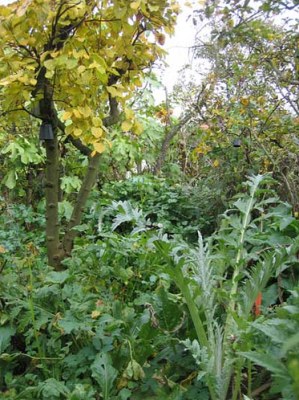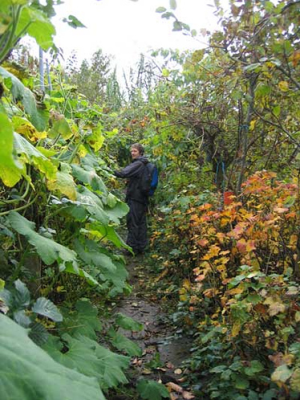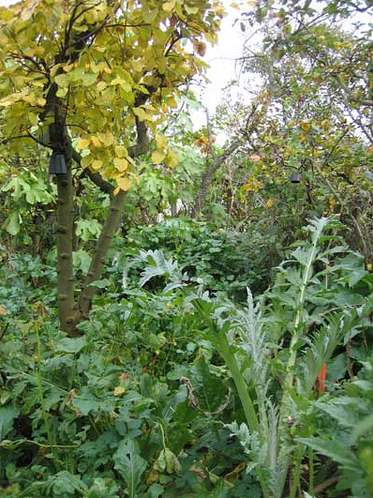A forest garden is a garden modelled on a natural woodland. It has 3 layers of vegetation: trees, shrubs and herbaceous plants. In an edible forest garden the tree layer contains fruit and nut trees, the shrub layer soft fruit and nut bushes, and the ground layer perennial vegetables and herbs. The soil is not dug and annual vegetables are not normally included unless they can reproduce by self-seeding. It is usually a very diverse garden, containing a wide variety of edible plants.
Many gardens contain the same things as a forest garden, but usually each is grown separately, as orchard, soft fruit aerea, vegetable patch and herb bed.
What distinguishes a forest garden is that all are grown together on the same piece of ground, one above the other.
Gardens like this have long been cultivated in many tropical countries, and are still in places as far apart as Central America, Tanzania and the Indian state of Kerala.
There are no hard rules about what a forest garden should be. In fact, every one should be different, tailored to the needs of the individual gardeners and their family, and to the unique environment of each garden.
What is the difference between a forest garden and permaculture?
Permaculture is an approach to food growing -and many other aspects of life- which takes natural ecosystems as its model.
Both learn from natural ecosystems. In case of the forest garden it is much a direct copy: a forest gardens looks like a woodland.
In contrary, permaculture is not modelled on the outward forms of ecosystems, but on the underlying principle which makes them work: a web of beneficial relationships between the different plants and animals, and between them and the rocks, water, soil and climate of their habitiat.
Natural ecosystems can be very productive, and they don’t need all the inputs of fossil fuels and other materials that are needed to support our present-day agriculture, industry and infrastructure, nor they emit any pollution.
Permaculture seeks to create systems which have all the desiderable characteristics of natural ecosystems but which provide for human needs. The key to achieving this is to set up a network of beneficial relationships between the different elements we need in a garden, on a farm or in a whole community.


the permaculture garden of Gilbert Cardon (fraternité ouvrière, Mouscron)
Forest gardening and permaculture are not the same thing, but there is much that they have in common. Both are about putting components together in an harmonious whole, so both have a strong element of design, and both are firmly rooted in a sense of ecology.
Permaculture covers a much larger field than (only) gardening. It includes farming, forestry, town planning, financial and social structures and much more. A forest garden may be a component in a permaculture design, but it is also more than just a part of permaculture. It is a way of gardening, indeed the basis for a way of living, which arose quite indepentdently: it can be practised by anybody who has access to a little piece of land, and who has the desire to try something that is relatively new and yet as old as life itself.
Why should we grow a forest garden?
The most sustainable way to grow food is the way which is most like the natural vegetation of that area. Let’s list some global benefits of growing a forest garden. The greatest ecological problem we face is climate change caused by the greenhouse effect. Growing new trees is one way to take carbon dioxide out of the atmosphere by turning it back into living wood. There is no reason why many of these desperately needed new trees should not be fruit-trees, planted by the owners of town and suburban gardens – who, at the same time, would gain the bonus of growing nourishing fruit. The ecological benefits of trees do not stop at being a sink for unwanted greenhouse gasses. They also enable the soil to store more water and then to release it slowly, preventing both flood and drought. They protect soil from wind and water erosion.
How a forest garden works.
First the vegetable layer comes into leaf, then the soft fruit and finally the top fruit. By working in layers, the lifespan of the growing season is extended. The whole volume of the soil can be used, without the plants competing with one another for water and nutrients. A forest garden can make much better use of the available resources –both above and below the ground- than a single layer garden.
The three main products of a forest garden are fuits, nuts and leafy vegetables. Often the distinction between vegetables and herbs is not really made. Anything that is edible and green, cultivated or wild, is welcome in the forest garden. We go for diversity! Many of the plants which are suitable for a forest garden are either taken straight from the wild or have only been slightly modified by plant breeding. Wild plants are on an average much higher in protein, vitamins and minerals than conventional vegetables. Most of the produce of a forest garden (fruits, nuts, salads) can be eaten raw.
There is no digging involved in a forest garden. Soil is not an inert mineral substance. It is an intricate blend of mineral, air, water, organic matter and living organisms. Crumb structure is an important element in fertility. The micro-organisms in the soil are the powerhouse of soil fertility. A lot of essential chemical processes are going on in the soil all the time, processes carried out by bacteria, fungi, algae and other micro-organisms.
In a forest garden, mulch plays an important part in weed control. There are not so many weeds in a forest garden anyway, as digging is the main thing encouraging weed seeds to germinate, and also because any plant that is useful in one way or another is welcome in a polyculture. Many wild plants are edible, and deep rooted ones work at bringing mineral nutrients up from the subsoil. Compost is not digged in, but placed on the surface as a mulch.
The diversity of a forest garden helps to keep it free from serious levels of pest infestation, due to the rich mixture of species and varieties within each of the layers.
Where each kind of plant is mixed in among many other kinds it is much more difficult for pests and diseases to build up. In addition to the benefits of general diversity, there may also be specific interactions going on. Some plants provide food for insects which are predators on plant pests. The greater the diversity of plants and the more they are intermingled the healthier the garden.
Make your own backyard ecosystem. It’s about the fascination of being a witness and a participant in the growth and the development of an ecosystem. A forest garden has a longer cycle. As trees, shrubs and perennial vegetables all grow at different rates they all have different lifespans. They spread and shrink in response to age and different seasons. Completed by the wild plants and animals that move into or out the garden as conditions change, a kaleidoscope of changes is unfolding as each year unfolds.
A forest garden is foremost a home garden. But with its combination of tree fruit, bush fruit and vegetables on the same piece of land it provides in the needs of its gardeners. And more, with the yield of a forest garden we can make a direct connection between growers and consumers, as home gardening avoids the costs of packaging and transport and allows for the return of all nutrients in the food by means of composting directly to the soil that grew that food. It is indefinitely sustainable. It is the basis of any truly ecological way of living that where we do things is at least as important as how we do them.
A forest garden does not need a lot of work, but it does need attention. It needs someone to wander through it regularly to see how it is getting on, it needs someone to inhabit it. This can happen without effort if the garden is at the gardeners’ workplace or living place.
Text inspired by Patrick Whitefield (How to make a Forest Garden)
